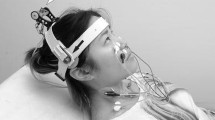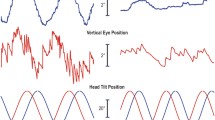Summary
(1) Compensatory slow phase movements were evoked by optokinetic, vestibular and combined optokinetic and vestibular stimulation. Superimposed fast phases resetting the position of the head (in space) and of the eye (in head) were recorded with a magnetic field search coil in unrestrained and head fixed frogs, respectively. (2) Head fast phases recorded during optokinetic stimulation covaried in the frequency of their occurrence with slow phase head velocity. Their amplitude was large (average 18.9 ±8.9 °), maximal velocity increased with amplitude by 6.67 °/deg, and duration (average 230 ±33 ms) was almost independent on amplitude. (3) Ocular fast phases rarely occurred during sinusoidal stimulation and neither optokinetic after nystagmus nor postrotatory nystagmus were observed. Fast phases, evoked by constant velocity optokinetic or acceleratory stimuli, consisted of two components: a primary resetting fast phase and a smaller fast movement in the opposite direction. The primary fast phase had a small amplitude (average 2.2 ±1.3 °). In different stimulus conditions fast phase parameters were very similar. Maximal velocity increased by 6.5 °/s/deg. Duration (average 165 ±23.4 ms) was variable. (4) During ocular fast phases the vestibulo-collic and the optokinetic-collic reflexes were suppressed. The slow phase head velocity either became zero or a small head fast phase in the direction of the ocular fast phase occurred. Fast phase head movements were accompanied by an ocular fast phase or by a retraction of one or both eyes, depending on the amplitude of the head fast phase. At the end of a head fast phase eye position was always recentered.
Similar content being viewed by others
References
Bahill TA, Clark MR, Stark L (1975) Dynamic overshoot in saccadic eye movements is caused by neurological control signal reversals. Exp Neurol 48: 107–122
Baker R, McCrea RA, Spencer RF (1980) Synaptic organization of cat accessory abducens nucleus. J Neurophysiol 43: 771–791
Bizzi E, Kalil RE, Tagliasco V (1971) Eye-head coordination in monkeys: Evidence for centrally patterned organization. Science 173: 452–454
Braun JJ, Gault FP (1969) Monocular and binocular control of horizontal optokinetic nystagmus in cats and rabbits. J Comp Physiol Psychol 69: 12–16
Collewijn H (1977) Eye- and head movements in freely moving rabbits. J Physiol 266: 471–498
Comer C, Grobstein P (1981) Tactually elicited prey acquisition behavior in the frog, Rana pipiens, and a comparison with visually elicited behavior. J Comp Physiol 142: 141–150
Crommelinck M, Roucoux A (1976) Characteristics of cat's eye saccades in different states of alertness. Brain Res 103: 574–578
Dieringer N, Precht W (1979) Analysis of head movements in the frog during optokinetic, vestibular and combined optokinetic and vestibular stimulation. Neurosci Lett (Suppl) 3: 281
Dieringer N, Blight AR, Precht W (1980) Optokinetic nystagmus of head and eye in the frog. Proc IUPS 14: 1221
Dieringer N, Precht W (1981) Functional restitution of static and dynamic reflexes in the frog after hemilabyrinthectomy. In: Flohr H, Precht W (eds) Proceedings in life sciences. Lesion-induced neuronal plasticity in sensorimotor systems. Springer, Berlin Heidelberg New York, pp 184–196
Dieringer N, Precht W (1982) Compensatory head and eye movements in the frog and their contribution to stabilization of gaze. Exp Brain Res 47: 394–406
Dieringer N, Precht W, Cochran SL (1982) Is there a velocity storage in the frog brain stem? Neurosci Lett [Suppl] (in press)
Easter SS (1971) Spontaneous eye movements in restrained goldfish. Vision Res 11: 333–342
Easter SS, Pamela JR, Heckenlively D (1974) Horizontal compensatory eye movements in goldfish (Carrassius auratus). I. The normal animal. J Comp Physiol 92: 23–35
Evinger C, Kaneko CRS, Fuchs AF (1981) Oblique saccadic eye movements of the cat. Exp Brain Res 41: 370–379
Fite KV, Reiner A, Hunt SP (1979) Optokinetic nystagmus and the accessory optic system of pigeon and turtle. Brain Behav Evol 16: 192–202
Fuller JH (1980) Linkage of eye and head movements in the alert rabbit. Brain Res 194: 219–222
Freund HJ, Büdingen HJ (1978) The relationship between speed and amplitude of the fastest voluntary contractions of human arm muscles. Exp Brain Res 31: 1–12
Gaupp E (1896) A Eckers und R Wiederheims Anatomie des Frosches, Bd 1. Vieweg, Braunschweig, S 1–229
Ghez C, Vicario D (1978) The control of rapid limb movement in the cat. II. Scaling of isometric force adjustments. Exp Brain Res 33: 191–202
Gresty MA (1975) Eye, head and body movements of the guinea pig in response to optokinetic stimulation and sinusoidal oscillation in yaw. Pflügers Arch 353: 201–214
Grüsser OJ, Grüsser-Cornehls U (1976) Neurophysiology of anuran visual system. In: Llinás R, Precht W (eds) Frog neurobiology. A handbook. Springer, Berlin Heidelberg New York, pp 297–385
Harris LR (1980) The superior colliculus and movements of the head and eyes in cats. J Physiol (Lond) 300: 367–391
Hermann HT (1971) Eye movement correlated units in mesencephalic oculomotor complex of goldfish. Brain Res 35: 240–244
Hermann HT, Constantine MM (1971) Eye movements in the goldfish. Vision Res 11: 313–331
Jürgens R, Becker W (1975) Is there a linear addition of saccades and pursuit movements? In: Lennerstrand G, Bach-y-Rita P (eds) Basic mechanisms of ocular motility and their clinical implications. Pergamon Press, Oxford New York Toronto, pp 525–529
Knudsen EI, Blasdel GG, Konishi M (1979) Sound localization by the barn owl (Tyto alba) measured with the search coil technique. J Comp Physiol 133: 1–12
Korn H, Bennett MVL (1975) Vestibular nystagmus and teleost oculomotor neurons: Functions of electrotonic coupling and dendritic impulse initiation. J Neurophysiol 38: 430–451
Lźár G, Kolta P (1979) The optokinetic head nystagmogram of the frog. Acta Physiol Acad Sci Hung 53: 479–486
Robinson DA (1981) The use of control systems analysis in the neurophysiology of eye movements. Ann Rev Neurosci 4: 463–503
Ron S, Robinson DA, Skavensky AA (1972) Saccades and quick phase of nystagmus. Vision Res 12: 2015–2022
Sandeman DC, Erber J, Kien J (1975) Optokinetic eye movements in the crab, Carcinus maenas. J Comp Physiol 101: 243–258
Schaefer KP, Meyer DL, Zieran H (1979) Neural activity pattern in different brain stem structures during eye-head movements. In: Granit R, Pompeiano D (eds) Progress in brain res, vol 50. Reflex control of posture and movement. Elsevier/North Holland, Amsterdam, pp 805–812
Takemori S, Suzuki J (1969) Influences of neck torsion on otolithogenic eye deviations in the rabbit. Ann Oto Rhinol Laryngol 78: 640–647
Vidal P-P, Roucoux A, Berthoz A (1982) Horizontal eye position related activity in neck muscles of the alert cat. Exp Brain Res 46: 448–453
Zangemeister WH, Jones A, Stark L (1981) Dynamics of head movement trajectories: Main sequence relationship. Exp Neurol 71: 76–91
Author information
Authors and Affiliations
Additional information
Supported by grants from Deutsche Forschungsgemeinschaft (Pr158/2) and Swiss National Science Foundation (3.505.79 and 3.616.80)
Rights and permissions
About this article
Cite this article
Dieringer, N., Precht, W. & Blight, A.R. Resetting fast phases of head and eye and their linkage in the frog. Exp Brain Res 47, 407–416 (1982). https://doi.org/10.1007/BF00239358
Received:
Issue Date:
DOI: https://doi.org/10.1007/BF00239358




